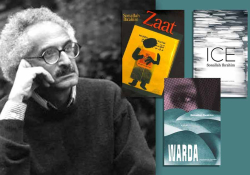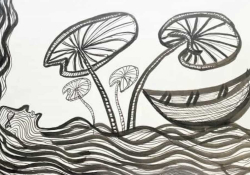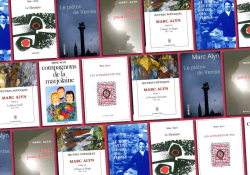Lost and Found in Translation: Storytelling and the Untranslatable

“Instead of a totalizing interpretation,” writes the author, translators should seek a dialogical one. “We have to leave space,” he writes, “for a story, an anecdote, a metaphorical footnote.”
We all spend a lot of time at airports. After having some coffee and browsing in shops that used to be duty-free, I always like to sit somewhere near a “Lost and Found” office. It is usually a quiet place. There is no one in, or there is someone bored, yawning. If you happen to lose your luggage and decide to report it to this person, he or she would look up and you would soon realize that there is no big difference between a “bored” and a “consoling” look. Anyway, I am sure that underneath these bored or sad looks there is something more. There are stories, tragedies, comedies, dialogues, misunderstandings. There is literature there. So, I would like you to treat this “Lost and Found” office as a key metaphor of this article.
Two years ago I translated a picture book for children by Oliver Jeffers, called Lost and Found (HarperCollins, 2010). It is a story about friendship. There is a little boy who finds a penguin at his door. He assumes that the wordless penguin is lost. When he discovers that penguins come from the South Pole, he takes him there in a rowboat. He helps the penguin ashore and casts off. On his way back the boy realizes his mistake: he had considered the penguin lost, but he was just lonely and looking for a friend. Eventually, they both found the friendship they had been looking for. Anyway, the title of the book is tricky, especially when you want to translate it into Polish: in English it sounds very normal, like a commonplace that you see at airports. Yet when you read the book, the title occurs to have a literal meaning: someone appeared to be “lost” but was eventually “found.” This trick gets completely lost in Polish translation. In Polish, the lost-and-found office is called “biuro rzeczy znalezionych,” which means “the found objects office” (like the German “Fundbuero” or Italian “Oggetti smarriti”). I had to give up and translate it as A Boy and a Penguin (so did the German translator, who chose Pinguin gefunden, and the Italian one, who chose Chi trova un pinguino . . .).
A secret dream, a fantasy, a fancy of all of us translators is to translate everything, translate fully, so there is nothing left.
We all had to give up because it was a title, so there was no room to use description, a so-called descriptive translation. I found it both frustrating and instructive. Frustrating because a secret dream, a fantasy, a fancy of all of us translators is to translate everything, translate fully, so there is nothing left. Then we can go to sleep satisfied. It was also instructive, because this is a well-known utopia of translators. Do not think of technical limitations. Think of the consequences: first, if there is nothing left to translate, there is no work for us and we are all soon on the dole. Second, from the biblical perspective, we move back to the pre-Babel time, at least in some way (there is no one language, but everything is available in all languages, so there is no room for misunderstanding), and God’s wrath will fall on us soon. Third, we end up with an Orwell-like vision of a uniform world, with no significant differences, with one voice and practically nothing important to talk about.
Utopias are warnings of what might happen if we are consequent. What might happen if we finally reach our goals. What might happen if we become too serious, too radical about something. Last but not least: utopias are persuasive when they are imaginable. So let us imagine.
Language is like a landscape: when we come to some foreign country for the first time, we tend to translate what we see (as new) into what we (already) know, what is seen into what is known.
Language is like a landscape: when we come to some foreign country for the first time, we tend to translate what we see (as new) into what we (already) know, what is seen into what is known. Let’s put it this way: if we come from a Christian country, where churches are an irreducible part of the landscape (like Poland), and we come to a country where there are mosques or synagogues instead, we in a way “translate” them into churches, we treat them as “their” churches. Thus we change the picture, change what we actually see into something already known. This is a translation: changing the unknown (part of a landscape or part of a language) into the known (part of a landscape or part of a language). There are also psychological reasons for this activity: we change the unknown into the known out of fear: mankind has always been afraid of the unknown. Perhaps that is the true trigger of epistemology, the study of knowledge. Perhaps knowledge is the unknown only translated into the known. Translated not really to know, but to overcome fear. When Nietzsche said that truth “is a mobile army of metaphors,” he meant that what appears to be truth is actually only made of language.[i] But metaphor is an elliptical simile, a trope of comparison. When we use a metaphor, we usually try to compare something unknown to something known. Besides, we usually use metaphors due to epistemological reasons: when we want to translate something unknown into something known.
When Lech Wałęsa, the Polish ex-president and leader of Solidarity, was in Japan, he gave a speech there in which he compared communists to a radish—a vegetable very popular in Poland. “Communists are like radishes,” he said, “red outside, white inside.” His interpreter immediately realized that Japan only has white radishes, so he ingeniously translated the sentence as: “Communists are like shrimps: red outside, white inside.” He knew that Walesa translated the (abstract) notion of communism into the (concrete) image of something we know well. Does it mean we all (both in Europe and in Japan) understand the notion? I think it means we only come close to it.
This metaphor is also a metaphor of what I have been talking about. We translate to know. Or to pretend we know. Translating seems to be a substitute of knowing. It is appreciating for us translators, but it is also depreciating for epistemology and for the whole idea of knowing. Why? Because you cannot say you know a foreign landscape if it has been translated into your landscape. You end up with a world that looks all alike—like a landscape around you.
When Roland Barthes, the French semiologist, was in Japan, one of the local newspapers announced his lectures. Above the announcement they published his photograph, retouched: his eyes were slightly slanted.[ii] To make him look more “normal” but also to “translate” him, to make him “ours.” It may sound ridiculous to most of us, but let’s face it: this is exactly what we, as translators, do all the time—we Photoshop.
It may sound ridiculous to most of us, but let’s face it: this is exactly what we, as translators, do all the time—we Photoshop.
It has always been like this. Translation was the very first hermeneutics. As you probably know, hermeneutics was invented as a way of making cultures compatible. In first-century Alexandria, it was necessary to combine two traditions: the Jewish one and the Greek one. The idea was—generally speaking—to find intersections between both traditions and to translate the rest in an allegorical way, to make us think the traditions fit. Otherwise, there would be war. For example, there is a famous sermon of Origen (from Alexandria) in which he explains why such an erotic text as the Song of Songs can be found among the holy books of the Bible.[iii] He interpreted it and, in a way, translated it in an allegorical way, forcing us to think that it is not about sex (which is obvious) but about a mystical connection between Christ and his ecclesia (the church). Sex has been always considered impure, so if the book had only a literal meaning, it would have been censored or even excluded from the Bible.
The so-called allegoresis (allegorical translation or interpretation) is always at work when culture is in danger, when it is necessary to save some “suspicious” texts.[iv] When we translate something allegorically, then we are able to tell the censors: “Look, it is not what you thought it was! It is so innocent! We can publish it! It is harmless!” I have at home a strange edition of Adam Mickiewicz’s poems published in the midst of the Stalinist era. It is not a political selection (which would be, I think, simply impossible), but there is a foreword there saying that maybe Mickiewicz wrote this, yet he really meant something else. If you read it now, it sounds ridiculous (a Romantic poet writing about the working class, against the bourgeoise), but it was the only way to publish it then.
It was a kind of hermeneutics, a saving act. Actually, the idea of hermeneutics was not only aimed at saving books or combining traditions and nations in a peaceful way. A hermeneutical attitude forces us to see only the things we have in common. There are books for children that teach us, from the beginning, how to ignore differences, how to think in terms of unification. They seem to say: if you look at someone and try to find what you both have in common, you are a good guy. If you see differences, it is a bad sign. We see differences when we are at war—that is what some sociologists say. War is a state of mind, and when we are at peace, when we want to build a united Europe, for instance, we must concentrate on the things we have in common.
It sounds nice, but isn’t it our well-known utopia? What does it mean “to see things in common”? Doesn’t it mean to omit differences? How can we omit anything if we are translators and we want to make everything readable and comprehensible? How can we admit that there is something so different and strange to our culture that we actually are not able to translate it? How can we be true?
Now, we have another solution for that. At least we have a name for it (since 1966): intertextuality, the theory that a text’s meaning is shaped by other texts. These texts were not chosen by its author but are “found” by its readers. It works a bit like the old game called “associations”: we refer what we read to what we have read before, regardless of what the author has read. Allusions to other texts work only if they are recognized by the readers (or rather “read in” by them). The intertextuality is especially complex in translation: we usually have two cultures and two traditions. And at least three sets of associations.
In one of Wisława Szymborska’s poems, there is a practically untranslatable line: “czerwone jabłuszko przekrojone na krzyż” (a red apple cut in four).[v] It is an allusion to a Polish folk song. A footnote would kill the poem. So, its translators—Stanisław Barańczak and Clare Cavanagh—decided to change it into a verse from some English folk song (also sentimental, full of melancholy), so we read “roses are red there and violets are blue.”[vi]
To sum up: intertextual translation is a translation of relations, not of real texts. We must change the texts to keep the relations. Of course, we cannot do it all the time: it would be ridiculous if a British literary character read a Polish book. Intertextuality can only be an additional solution for us.
I can hardly call myself a patriot, at least in a nineteenth-century meaning. If I am a patriot at all, I would be a patriot of language. I like the language I live in. I like to speak it, write in it, and play with it. I would even say that the Polish language, my attitude to it, has created my identity. Is identity translatable? I would argue that a translated identity is not identity anymore. Not the identity at least. The whole concept of identity, both a philosophical and a psychological one—of uniqueness, of sameness—excludes translatability.
What makes us unique—as a nation, as a society, and especially as a culture—is untranslatable.
My thesis is: what makes us unique—as a nation, as a society, and especially as a culture—is untranslatable. It gets lost in translation. Identity is what stays on the desktops of translators, when they finish the work.
As a translator I live between two languages. I am not bilingual, though. I do not mix them up. As a translator I like turning English words into Polish words, sentences into sentences. I am satisfied only when I have a feeling there are no signs that the sentence I translated used to be an English sentence once. But I also learned to be aware of the “rest that stays,” of the rest I was not able to translate. What is the rest?
My main field of interest is rhetoric. I specialize in finding rhetorical figures and tropes in literature and visual arts. Being both a translator and a rhetorician, I feel authorized to say that the rhetorical layer of culture is especially untranslatable. I mean figural speech and other persuasive devices. There is a story by Leszek Kołakowski, a famous Polish philosopher.[vii] In it, some archaeologists, say, three hundred years from now, find a speech of President John F. Kennedy. The president says: “What is a million now? It is like a piece of cake.” The archaeologists try to interpret this sentence (which is not quite clear to them), and they decide that it means: a piece of cake cost as much as . . . one million dollars. This misunderstanding seems funny: the archaeologists simply did not recognize a rhetorical device and read the sentence literally. Kołakowski used the story to prove that we should not trust ourselves as readers of the past. I would say that it also proves that rhetorical devices are especially difficult to translate. They are also quite tricky: we are never warned if something is or is not figurative. As readers—not only of the past but also of foreign languages, foreign cultures—we have to take the risk of such misunderstandings.
A friend of mine who is a professor of Polish literature at Stockholm University told me that one of his students translated a short story by the Polish realist author Marek Hłasko. We read there about a drunk man who comes into a bar a “releases a peacock.” It is a slang expression meaning “to vomit, to throw up.” The student did not know this expression, so he translated it literally. It became quite a strange scene, especially strange in a realistic short story. The translator was aware of that, so he had to make the scene credible, think up an explanation for the bird in the bar. So, he added a sentence before it, and in his Swedish translation we read that a drunk man came into a bar carrying a huge bag, opened it, and released a peacock. A Swedish reader would think that it is a peculiar, cruel Polish tradition to carry peacocks in bags and then release them in a fit of patriotism. This misunderstanding was especially funny, and there are probably lots of them in all languages. Let us not treat them as jokes only, however. Let us treat them as arguments to support my thesis: rhetorical figures and tropes are especially difficult to translate.
But the last example is not only a figure. It is also a topos, a theme, a commonplace. Something that appears and reappears in any culture, in the form of sentences, motives, images. Rhetoricians and literary theorists divide them into several categories.[viii] There are (1) so-called universal topoi, based on archetypes invented and named by Carl Gustav Jung. They are, generally speaking, images common to all mankind, having more or less the same meaning (mother, road, home, fire, water, forest, garden) and thus being almost fully translatable. (Well, almost fully: a home, as a place, is an empty sign for nomadic peoples; it also means something different in Europe and in the United States.) There are also (2) so-called cultural topoi, understood within a culture—like the Achilles heel or the Christian cross or the biblical Ark of the Covenant. They are fully translatable within the culture. Outside of it, they need footnotes.
And then there are (3) the national topoi. They are conditioned by national culture, tradition, history, and language. If you are not Polish or if you have not been brought up in the patriotic tradition of Henryk Sienkiewicz, you probably would not know the expression (and image) of two naked swords. And if you are not Polish, the word “fence” does not have any extra meaning. For us it may be an allusion to Lech Wałęsa, who jumped over a fence in the Gdansk shipyard to start the Solidarity movement. And one of my favorite topoi is a round table. In English tradition, it evokes the legends of King Arthur and his faithful knights. In Polish tradition, it evokes the piece of furniture at which our last bloodless revolution was made: the revolution that let us join the free European countries in 1990. If you translate such a topos from English to Polish (or the other way around) in a mechanical way, you end up with a misunderstanding.
It is a paradox. The word topos means “place.” It is a shortened version of topos koinos, which means a common place. Topoi should be common, then, they should make a platform for understanding. Yet when you take a closer look, you realize that they are understood only within a culture. They do not make a platform for understanding between cultures. They are absolutely private. Besides, they have a tendency to change. We forget them if we do not recall them. And from time to time a new one appears. In Poland, historical changes are very fruitful when it comes to topoi.
In all languages, literatures, and traditions we may easily recall such topoi, such private images or expressions. Absolutely untranslatable, absolutely specific, confined to one language, literature, tradition, or culture. Expressions or images that need a footnote in translation. And that is what makes them determinants of our linguistic, literary, traditional, or cultural identity.
The conclusion is that the rhetorical dimension of language and culture seems to be the untranslatable “rest that stays” and is responsible for our identity. We all know—from Nietzsche or American deconstructionists—that rhetoric is the core of language. We cannot get rid of rhetoric. If we try, we will end up with nothing, not to mention no identity.
As a translator, I cannot get rid of the rhetorical layer of language; I cannot translate it either. What can I do then? Well, there are two solutions: I can change jobs for an easier one, or I can try to translate it descriptively. Add a footnote, tell a story. I would not Photoshop. I would not polish it up (pardon the ambiguity). I would not try to find an equivalent if I had an opportunity to describe and tell a story. So, my advice is: translate descriptively. If we come across something that does not have a clear synonym, describe it. Tell a story. The story about Wałęsa and shrimps becomes interesting when you decide to tell it, describe it. It shows cultural differences. It shows that what is important is untranslatable. But being untranslatable does not mean it cannot exist in a different language or culture. It can. Not as a synonym but as a story, as a narrative.
I believe we translators have a right to tell stories.
I believe we translators have a right to tell stories. Stories make the world go round. Stories are a basis for dialogue. A dialogue is what makes our culture last. As philosophers say, the aim of philosophy today is not reaching or unveiling the truth. There is no such thing as “the” truth, one truth. There are many truths, irreducible, untranslatable into one. All we can do now is talk. Keep the dialogue ongoing, keep talking, to keep the culture alive. Dialogue, however, needs not only many people but also many points of view, many opinions—many, we could say, languages. If everything is fully translatable and gets translated, the dialogue will cease. And that (paradoxically) will be the end of culture.
Let me conclude now. What I suggest is a revaluation of hermeneutics. Translation should not be merely an interpretation. We should not only interpret texts and present them in a different language. It is too risky, because then it is very easy to lose what is really important: our cultural identity. Instead of a totalizing interpretation, I would suggest a dialogical one. The one that opens a discussion, not closes it definitively. We have to leave space for a story, an anecdote, a metaphorical footnote, that will show our professional sincerity and a will to save the untranslatable and not pretend we can translate everything. The paradox is that the more we lose (as translators), the more is found. We lose to find—to find a key to keep our cultures alive.
Kraków
[i] F. Nietzsche, About Truth and Lies in an Extra-moral Sense, in Nietzsche’s Seven Notebooks from 1976: Translations and Illuminations by Daniel Fidel Ferrer (Kuhn von Verden Verlag, 2020), 122.
[ii] Barthes, The Empire of Signs, trans. Richard Howard (Hill & Wang, 1983), 114.
[iii] Origen, The Song of Songs: Commentary and Homilies, trans. R. P. Lawson (Longmans, 1957).
[iv] C. S. Lewis, The Allegory of Love: A Study in Medieval Tradition (Cambridge University Press, 2013).
[v] Szymborska, Z nieodbytej podróży w Himalaje, in Wołanie do Yeti (Wydawnictwo Literackie, 1957), 42.
[vi] Szymborska, Map: Collected and Last Poems, trans. Clare Cavanagh & Stanisław Barańczak (Houghton Mifflin Harcourt, 2015), 48.
[vii] Kołakowski, 13 bajek z królestwa Lailonii dla dużych i małych oraz inne bajki (Prószyński i S-ka, 1998).
[viii] Ernst Robert Curtius, European Literature and the Latin Middle Ages, trans. Willard R. Trask (Princeton University Press, 2013).
















